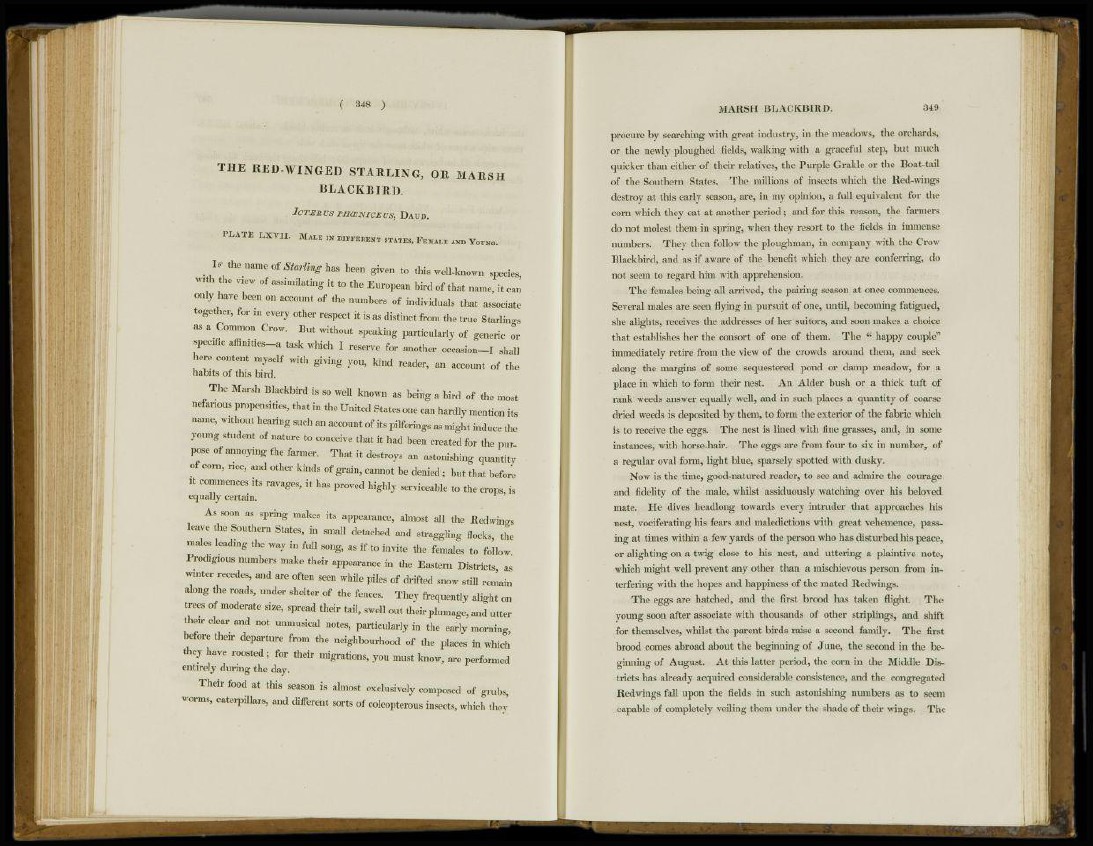
( 348 )
T H E R E D - W I N G E D S T A R L I N G , O R M A R SH
B L A C K B I R D .
ICTERUS PH&NICEUS, DAUD.
P L A T E L X V I I . MALE IN DIFFEIIENT STATES, FEMALE AND YOUNG.
I F the name of Starling has been given to this well-known species,
with the view of assimilating it to the European bird of that name, it can
only have been on account of the numbers of individuals that associate
together, for in every other respect it is as distinct from the true Starlings
as a Common Crow. But without speaking particularly of generic or
specific affinities—a task which I reserve for another occasion—I shall
here content myself with giving you, kind reader, an account of the
habits of this bird.
The Marsh Blackbird is so well known as being a bird of the most
nefarious propensities, that in the United States one can hardly mention its
name, without hearing such an account of its pilferings as might induce the
young student of nature to conceive that it had been created for the purpose
of annoying the farmer. That it destroys an astonishing quantity
of corn, rice, and other kinds of grain, cannot be denied; but that before
it commences its ravages, it has proved highly serviceable to the crops, is
equally certain.
As soon as spring makes its appearance, almost all the Redwings
leave the Southern States, in small detached and straggling flocks, the
males leading the way in full song, as if to invite the females to follow.
Prodigious numbers make their appearance in the Eastern Districts, as
winter recedes, and are often seen while piles of drifted snow still remain
along the roads, under shelter of the fences. They frequently alight on
trees of moderate size, spread their tail, swell out their plumage, and utter
their clear and not unmusical notes, particularly in the early morning,
before their departure from the neighbourhood of the places in which
they have roosted; for their migrations, you must know, are performed
entirely during the day.
Their food at this season is almost exclusively composed of grubs,
worms, caterpillars, and different sorts of coleopterous insects, which they
MARSH BLACKBIRD. 349
procure by searching with great industry, in the meadows, the orchards,
or the newly ploughed fields, walking with a graceful step, but much
quicker than either of their relatives, the Purple Grakle or the Boat-tail
of the Southern States. The millions of insects which the Red-wings
destroy at this early season, are, in my opinion, a full equivalent for the
corn which they eat at another period; and for this reason, the farmers
do not molest them in spring, when they resort to the fields in immense
numbers. They then follow the ploughman, in company with the Crow
Blackbird, and as if aware of the benefit which they are conferring, do
not seem to regard him with apprehension.
The females being all arrived, the pairing season at once commences.
Several males are seen flying in pursuit of one, until, becoming fatigued,
she alights, receives the addresses of her suitors, and soon makes a choice
that establishes her the consort of one of them. The " happy couple"
immediately retire from the view of the crowds around them, and seek
along the margins of some sequestered pond or damp meadow, for a
place in which to form their nest. An Alder bush or a thick tuft of
rank weeds answer equally well, and in such places a quantity of coarse
dried weeds is deposited by them, to form the exterior of the fabric which
is to receive the eggs. The nest is lined with fine grasses, and, in some
instances, with horse-hair. The eggs are from four to six in number, of
a regular oval form, light blue, sparsely spotted with dusky.
Now is the time, good-natured reader, to see and admire the courage
and fidelity of the male, whilst assiduously watching over his beloved
mate. He dives headlong towards every intruder that approaches his
nest, vociferating his fears and maledictions with great vehemence, passing
at times within a few yards of the person who has disturbed his peace,
or alighting on a twig close to his nest, and uttering a plaintive note,
which might well prevent any other than a mischievous person from interfering
with the hopes and happiness of the mated Redwings.
The eggs are hatched, and the first brood has taken flight. The
young soon after associate with thousands of other striplings, and shift
for themselves, whilst the parent birds raise a second family. The first
brood comes abroad about the beginning of June, the second in the beginning
of August. At this latter period, the corn in the Middle Districts
has already acquired considerable consistence, and the congregated
Redwings fall upon the fields in such astonishing numbers as to seem
capable of completely veiling them under the shade of their wings. The